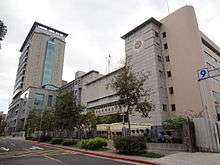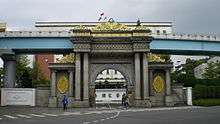National Police Agency (Taiwan)
The National Police Agency, Ministry of the Interior (NPA; Chinese: 內政部警政署; pinyin: Nèizhèngbù Jǐngzhèngshǔ; Pe̍h-ōe-jī: Luē-chèng-pō͘ Kéng-chèng-sú) is an agency under the Ministry of the Interior of the Republic of China (Taiwan) which oversees all police forces on a national level. The National Police Agency is headquartered in Taipei City.
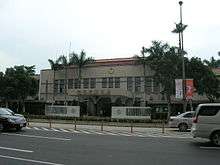
| National Police Agency 警政署 Jǐngzhèngshǔ (Mandarin) Kín-chṳn-su (Hakka) | |
|---|---|
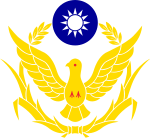 | |
| Abbreviation | NPA |
| Agency overview | |
| Formed | 5 July 1972 |
| Preceding agency |
|
| Employees | 73,727 |
| Jurisdictional structure | |
| National agency (Operations jurisdiction) | Republic of China (Taiwan) |
| Operations jurisdiction | Republic of China (Taiwan) |
| Legal jurisdiction | Free area of the Republic of China |
| Operational structure | |
| Headquarters | Zhongzheng, Taipei |
| Agency executives |
|
| Parent agency | Ministry of the Interior |
| Website | |
| www.npa.gov.tw | |
Police Organization & Structure
Hierarchy
Most actual law enforcement and day-to-day policing duties are delegated to local police departments on a city and county level which answer to the NPA but are considered agencies of their local government. However the NPA has direct control over several specialized units which may be deployed to assist local forces, as well as the national highway patrol.
Unlike the police system in the United States, the central government appoints the head positions of city and county Police Departments in the ROC and thus forms a solid chain of command for all police personnel. By calling a personnel review board, the Director-General of NPA has the full control of personnel rotation and transfer,[1] as well as administrative commendations and reprimands over all high ranking police officers, including chiefs of local police departments.[2]
One exception is the President of the Central Police University, who is directly subordinate to the Minister of the Interior, and is not subject to the NPA personnel review board.
-
- National Police Agency
- NPA Units/City and County Police Departments (縣市警察局)
- Precinct/Division/Squad
- Station
- Beat
NPA Units
In addition to its own internal administrative offices, the NPA has direct control over the following units and agencies:
Criminal Investigation Bureau
The Criminal Investigation Bureau (CIB) is responsible for the investigation of high-profile crimes, forensics, and computer-related crimes. Under its command, are the following field and staff sections:
- Crime Prevention and Detection Command Center: Code-named Telephone Extension Number 8[3].
- Crime Prevention Section
- Crime Investigation Section
- Anti-Hoodlum Section
- Laws & Regulations Research Section
- Criminal Records Section
- International Criminal Affairs Section
- INTERPOL Radio Center
- Research & Development Office
- Public Relations Office
- Logistics Section
- Secretariat
- Internal Affairs Office
- Public Security Office
- Personnel Office
- Accounting Office
There are also nine active field police squads[4]
- 1st brigade: Homicide or unregistered weapons.
- 2nd brigade: Robbery or sex-related crimes.
- 3rd brigade: Controlled substances or organized crime.
- 4th brigade: Burglary, kidnapping or blackmail.
- 5th brigade: Bombs or explosives.
- 6th and 8th brigades: Rapid reaction units in central and southern Taiwan.
- 7th brigade: Financial crimes.
- 9th brigade: Cybercrimes.
Two task-force-grouped centers include:[4]
- Forensic Science Center:
- Forensic Section(Criminalistics Office): The Emeritus consultant is Henry Chang-Yu Lee, Ph.D., in Connecticut, United States.
- Forensic Biology Office(Medical Examiner Office): The Emeritus consultant is Yang Zi-song(zh:楊日松), M.D., retired.
- Fingerprint Office
- High-Technology Crime Prevention Center:[5] It formed on April 6th, 2006.
- 9th brigade
- Electronic surveillance and monitoring center (on cellular telephone networks in private corporations, such as FET)
- Information management office
Special Police Corps
There are 7 individual Special Police Corps, literally "Security Police Corps"(保安警察隊). These are mobile, rapid deployment police forces. They also execute various sentry duties and serve as a pool of reserve formations for police manpower.
Three task-force-grouped SWAT units (referred to as Peace Enforcing Special Service Forces or "Wei-An" Forces(zh:維安特勤隊)[6] comprise the 1st, 4th and 5th Special Police Corps. The mission of the "Wei-An" Forces include counter-terrorism, counter-hijacking, high-profile hostage rescue, and presidential protection. In recent years they have also been involved in the arrest of heavily armed fugitives. The uniforms and equipment of the Wei-An units are similar to local SWAT units, which are referred to as Thunder Squads. The Thunder Squads are subordinate to local police departments. However, the "Wei-An" Forces are the only police units equipped with V-150S armor vehicles and M998 Humvee, which were transferred from ROC Army after the 2004 shoot out with Zhang Xi-Ming (zh:張錫銘).[7]
The First Corps
A training base for courses of on-the-job training and mobile task force. Riot control, Special Weapons and Tactics, counter-terrorism in northern Taiwan. It commands six special police brigades and one "Wei-an" Forces(zh:維安特勤隊). Three brigades of conscripts, 2nd, 5th and 6th, served like combat police in Korea, are usually deployed for Riot control.
- Corps Headquarters, 2nd, 3rd, 4th brigades, and one "Wei-An" Forces, are stationed in Si-pai, Taipei City.
- "Wei-an" Forces: Formed in June 1992. Its mission specialties are counter-terrorism, high-profile hostage rescues, and presidential protection. These forces are composed of SWAT units divided into two companies, which are supported by the 3rd brigade.
- 1st and 5th brigades are stationed in Sanxia District, New Taipei City.
- The 6th brigade is stationed in Bade District, Taoyuan City.
The Second Corps
There are 4 brigades commended by the Ministry of Economic Affairs. It is for security duty of all governmental business units and Taiwan Power Company under the Ministry of Economic Affairs and all Science Parks of National Science Council.
- The first brigade is especially tasked for the copyright protection and the enforcement of counterfeit and infringement in related to intellectual property. It is usually code-named as Intellectual Property Protection Brigade.
- The 2nd is to guard three nuclear power plants (Nuclear No.1, No.2, and No.4) of Taiwan Power Company in New Taipei City.
- The 3rd is in northern Taiwan for the security duty of two Science Parks in Hsinchu and Taichung under National Science Council, and the other industrial parks, import-export districts, and certain government installations of the Ministry of Economic Affairs.
- The 4th is in southern Taiwan for the security duty of all governmental business installations under the National Science Council and the Ministry of Economic Affairs, which includes one nuclear power plant: "Nuclear No.3."
The Third Corps
It is a part of border police and provides supportive and supplemental duty of Customs Services of Ministry of Finance.
The Fourth Corps
Riot control, Special Weapons and Tactics, counter-terrorism in central Taiwan.
- "Wei-an" Forces: In March 2003, two more task force-sized SWAT groups of "Wei-an" Forces were formed. One of them is attached to the 4th Special Police Corps in Taichung, which is located in central Taiwan.
The Fifth Corps
Riot control, Special Weapons and Tactics, counter-terrorism in southern Taiwan.
- "Wei-an" Forces: In March 2003, two task-force SWAT groups were formed. One is attached to the 5th Special Police Corps in southern Taiwan.
The Sixth Corps
Responsible for the physical security of central government buildings, high-ranking civilian officials, foreign embassies, and liaison institutes.
Taiwan Special Police Corps
There are 6 Special Police Brigades inherited from the late Taiwan Provincial Police Administration.
- The first 3 brigades are for the security duty of 3 governmental financial banks: Taiwan Land Bank, Taiwan Cooperative Bank, and Bank of Taiwan.
- The 4th is to guard the government installations related to the late Taiwan Province.
- The 5th and 6th are attached to Water Resources Agency (水利署), Ministry of Economic Affairs to protect the water supply and water-and-land-related environmental cases.
Other NPA Units
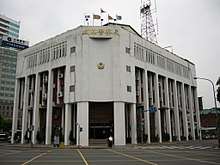
The Immigration Office (入出境管理局) is removed from NPA and attached to the National Immigration Agency and since 2 January 2007.
- National Highway Police Bureau (國道公路警察局): Jurisdiction over national highways.
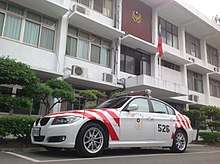
- Harbor Police Offices (港務警察局): Part of border police in Taiwan. There are 4 separate offices with jurisdictions over the ports of Keelung, Taichung, Kaohsiung and Hualien.
- Railway Police Bureau (鐵路警察局): Jurisdiction over stations and facilities of Taiwan Railway Administration since 1949 and Taiwan High Speed Rail since 26 December 2006.
- The 1st section: facilities of TRA, north of Taichung in western Taiwan
- The 2nd section: facilities of TRA, south of Taichung in western Taiwan
- The 3rd section: facilities of TRA in eastern Taiwan
- The THSR section: facilities of THSR
- Aviation Police Bureau (航空警察局): The Airport police is a part of border police and responsible for safeguarding, traffic administration, crime investigation, documents inspection, security examination etc. at local civil airports in the ROC. Its headquarters is at Taiwan Taoyuan International Airport.
- National Park Police Corps (國家公園警察大隊): Jurisdiction over the national parks, specialization in search and rescue operations.
- Taiwan Police College
- Police Armory (警察機械修理廠)
- Police Telecommunications Office (警察電訊所)
- Civil Defense Headquarters (民防防情指揮管制所)
- Police Radio Station (警察廣播電臺): A government public radio station run by civilians. It broadcasts regular radio show programs, news, and real-time traffic situations.
Task-Force Formations under NPA
By separate decrees of The Executive Yuan, three task-force formations, each consisted of roughly a couple of hundreds police officers with different specialty, are formed under the National Police Agency but attached to two cabinet-level institutions or other units.
- Telecommunication Police Corps (電信警察隊): In January 1998, a task force called the "Telecommunication Police Corps" was formed and attached to the Ministry of Transportation and Communications. Since 2 February 2006, the Telecommunication Police Corps are re-attached to the National Communication Commission. Its job is to enforce laws concerning the radio spectrum and telecommunications.
- Environmental Protection Police Corps (環保警察隊): It was formed in 1999 and is attached to the Environmental Protection Administration. There are currently 192 policemen serving as Environmental Protection Police and assigned to three brigades at Taipei City, Taichung City and Fongshan City in Northern, Central and Southern Taiwan, respectively.
- Forest & Nature Conservation Police Unit (森林暨自然保育警察隊): This was formed with 178 policemen on 1 July 2004 by the decree of the Executive Yuan on 6 August 2003, after ten forest arson cases in the mountain area of Taichung County (now part of Taichung City) within six years. It is attached to the Forest Bureau of the Council of Agriculture. Besides its headquarters in Taipei City, there are 8 squadrons in Taiwan mountain area. Its main task is to support the forest patrolmen to preserve and protect the ecology system and all historic monuments in all the forests in Taiwan.
Local Agencies
Local police departments exist for all administrative divisions above the county/provincial city level. There are 26 local departments in total. All local agencies are subordinate to the NPA as well as their respective local government, and all police officers wear the same uniform regardless of jurisdiction.
Local city and county governments are responsible for allocating funds for their local police departments and local police chiefs must attend city or county council meetings to answer questions from council members. While all high ranking police officers are subject to personnel rotation and transfer by the NPA, under the wake of local autonomy beginning in 1990, the NPA Director-General will usually consult with local officials regarding the appointment of local police chiefs.[1]
Municipal Police Departments
The Police Commissioners of the Taipei and Kaohsiung City Police Departments hold the rank of "Director-General, first level,"[8] which is the same as the Director-General of National Police Agency, before 2007.
Before 2007, although the Directors-General of the Taipei and Kaohsiung City Police Departments hold the same rank as the Directors-General of National Police Agency and Central Police University, the latter two are both presidential commissions and appointed by the Minister of the Interior. As a courtesy, the two local Directors-General usually wear a lower rank in public.[9]
After 2007, the rank Directors-General Supreme is created and specifically offered to the Director-General of National Police Agency. Currently, each of all 6 city police departments of special municipalities (Taipei City, Kaohsiung City, New Taipei City, Taichung City, Tainan City, Taoyuan City) is headed by a Director-General Level 1, and no longer wears a lower rank in public.
Taipei City Police Department
[10][11] Somehow different from the Police system of Japan, in the capital Taipei City, the city government has its own Taipei City Police Department and a subordinate criminal investigative force, "Criminal Investigation Division", which is also an active and famous police force in the field.
Kaohsiung City Police Department
In retrospect to the organization of police administration of Kaohsiung City, it has gone through history and experienced the great changes of the society. In fact it has to be traced back to the time of Japanese colonization. At that time there was the establishment of Eastern Police Office, Western Police Office, Marine Police Office and Fire Police Office.
After the end of Japanese colonization in October 1945, they were used continuously until the official establishment of Police Office of Kaohsiung City on 8 November 1945. This new police office was in charge of the maintenance of law and order of the whole city. On 14 February 1946, there was the establishment of the 1st and 2nd Precincts, Marine Branch Office and Fire Office. In 1958 the Police Office of Kaohsiung City was permitted to be promoted as a police department of Grade B system. Meanwhile, two more Precinct Offices were added.
On 1 July 1970 the police office was furthermore promoted as the only one belonging to Grade A system in Taiwan Police System. Under it, there were 7 Police Precincts established. On 1 July 1979 Kaohsiung City was officially promoted as a special municipal city under the central government. The Police Office of Kaohsiung City was officially named as Kaohsiung Municipal Police Department.
Island Police Departments in Fujian
Kinmen and Lien-chiang County Police Departments are two local agencies which are historically out of the mainstream of Taiwan police system. The local police forces were merged into the two respective military theater garrison commands once or twice.
Since the direct travel between mainland China and Kinmen and Matsu was opened in 2002, the local police departments are put on heavier duty of border security and immigration checking.
Kinmen County Police Department
Its root can be traced back to China in 1915. The local police department was once disbanded in 1949 and replaced by the military security forces under the Kinmen garrison command. Then, in 1953, along with the reinstatement of Kinmen County government, Kinmen PD was detached from military command and assigned to the county government, which was still under the oversight of Kinmen military committee until 1992.
Today, its table of organization contains 312 police officers and three field police brigades: Forces of "Criminal Investigation", "Special Police" and "Traffic Police."
There is no police precincts(分局) in Kinmen. The Kinmen County Police Department has direct control over its six police institutes(所), which are somehow between the level of "police precinct" and "police station."[12]
"Wu-chiu dispatched Police Station" is attached to the Kinmen County Police Department for the convenience of administration.
Lienchiang County Police Department
It is stationed at Matsu Islands.
Lien-chiang County Police Department was formed with 17 police officers in 1956 as a military security detail "Lien-chiang County Police Institute" under Matsu military committee. In December 1965, it was re-designated as "Lien-chiang County Police Department." In May 1967, it was then separated from a military unit and turned into a real civilian police force with four dispatched police stations.
After two expansions in June 1979 and in November 1998, it now contains 124 police officers and two field police brigades: Forces of "Criminal Investigation" and "Special Police and Traffic."
In August 2001, Lien-chiang County Police Department reorganized and upgraded its four dispatched police stations to four "police institutes." Among them, two police stations are added to "Nankan Police Institute" and one "Dongjyu Police Station" on Dungjyu island is formed up and subordinated to "Chukuang Police Institute."
Ranks
Rank insignias are worn over the right breast pocket when in uniform.
| Rank | Insignia |
|---|---|
| Police Rank 4 警佐四階 | One Star on One Horizontal Bar |
| Police Rank 3 警佐三階 | Two Stars on One Horizontal Bar |
| Police Rank 2 警佐二階 | Three Stars on One Horizontal Bar |
| Police Rank 1 警佐一階 | Four Stars on One Horizontal Bar |
| Police Officer Rank 4 警正四階 (Inspector)(Sub-Lieutenant) | One Star on Two Horizontal Bars |
| Police Officer Rank 3 警正三階 (Senior inspector)(Captain) | Two Stars on Two Horizontal Bars |
| Police Officer Rank 2 警正二階 (Superintendent) | Three Stars on Two Horizontal Bars |
| Police Officer Rank 1 警正一階 (Senior Superintendent) | Four Stars on Two Horizontal Bars |
| Police Supervisor Rank 4 警監四階 (Superintendent General) | One Star on Three Horizontal Bars |
| Police Supervisor Rank 3 警監三階 | Two Stars on Three Horizontal Bars |
| Police Supervisor Rank 2 警監二階 | Three Stars on Three Horizontal Bars |
| Police Supervisor Rank 1 警監一階 | Four Stars on Three Horizontal Bars |
| Police Supervisor Rank Supreme (Police General) 警監特階 |
Sources: ROC Coast Guard Ranks
Before 1999, the lowest-grade street policemen held the rank of Police Officer II, denoted by an insignia of two stars on one horizontal bar, sometimes referred to colloquially as "一毛二" or "one dime and two cents." On 3 March 1999, an adjustment of "the table of police positions and corresponding ranks" or "各級警察機關學校警察官職務配階表", from the Ministry of Interior resulted in regular policemen or women on street holding the rank of Senior Police Officer, denoted by "three stars on one horizontal bar", nicknamed "一毛三" or "one dime and three cents."[13][14]
To emphasize the independence of the ranks and the professions, the rank of ROC police may not perfectly match their positions in a station. In 2007, a highest rank above Police Supervisor Rank 1 is created for the highest position, Police General, who is in charge of and oversees the public safety of the entire nation.[15]
History
The current police service in Taiwan traces its roots back to police forces established in Taiwan during Japanese colonial rule, as well as police services established in Mainland China during the early 20th Century.[3]
Japanese Colonial Police

The first formal police forces in Taiwan were organized by the Japanese Colonial Government which oversaw Taiwan between 1895 and 1945. In the early years of Japanese rule, rebellions were common especially in rural areas. With the passage of the "Bandit Laws", police forces as well as garrison units from the Japanese military were tasked with suppression of rebels, though large scale rebellions had largely died out by 1902. Military and police forces were also involved in the efforts of the colonial government to secure control over the mountainous regions of Taiwan from the Taiwanese aborigines around 1910, and a series of smaller attempted rebellions and civil disorders between 1912 and 1916 . With the gradual acceptance of Japanese rule sinking in among the general populace by the 1920s, most agitators turned to seeking political change and reform within the established system in the home rule movement, Secret police forces were tasked with keeping a close watch[3] on political groups and agitators.
Most of the members of the police forces during this time were expatriate Japanese, though towards the latter period of Japanese rule, locals began to be recruited. Throughout much of this time, the police forces were granted broad power and authority and allegations of police brutality were common, especially during the earlier periods of Japanese rule. Consequently, they were not particularly liked by the general populace,[16] and were often viewed as a symbol of the more oppressive side of Japanese rule; though this gradually changed with the stabilization of the political situation. Nonetheless, Japan was generally credited for formally establishing law and order in what had previously been a hotbed of rebellion and lawlessness during Qing Dynasty rule. Much of the law enforcement infrastructure and traditions developed during this time would continue to be used under postwar ROC rule.
Police in the early ROC
The ROC's law enforcement system built upon the foundations laid down during the Qing Dynasty with the establishment of the Peking Public Inspection Headquarters in 1902. Following the overthrow of the Qing Dynasty and the establishment of the Republic in 1912, a National Police Department was established under the auspices of the Ministry of the Interior. This early centralized system consisted of a national headquarters in the capital, provincial police administrations for each province, police departments and bureaus at the municipal and county level respectively. This system was extended to Taiwan following its transfer to ROC control in 1947, two years after the close of hostilities in World War II, though the basic system from the Japanese era was retained.[3][17]
Martial Law
During the period between 19 May 1949 and 14 July 1987, the Taiwan police system had a controversial page in Taiwan history.
Between 1945 and 1988, police officers in Taiwan wore khaki uniforms with khaki combination caps similar to those worn by naval officers, or with white plastic helmets similar to the U.S. Navy Shore patrol. Critics noted the similarity to military uniforms, eventually leading to the revision of police uniforms in 1988.
On 5 February 1951, by the power of the now-abolished law of contravention, police officers could grab men with long hairdo and use scissors to cut the men's long hair. So applied to mini-skirts, Hawaii shirts, flared trousers, or other clothes of the men or women with irregular dressing. On 5 February 1972, Taipei City Police Department even launched a mass-detainment against people who dressed like hippies.[18]
In 1972, to streamline organizational costs, the National Police Department was merged with the Taiwan Police Administration to form the new National Police Agency (NPA).[17]
The first 4 Directors-General of NPA, between 1972 and 1990, were active general officers transferred from Army or Marine Corps:
- Chou Ju-cun (周菊村), between 1972 and 1976;
- Kong Ling-Cheng (zh:孔令晟), between 1976 and June 1980;
- Ho En-ting (何恩廷), between June 1980 and 1 August 1984;
- Luo Chang (羅張),[19] between 1 August 1984 and 4 August 1990.
The latter three even served as two-star Marine Corps Commandants.
Secret police organizations
Historically speaking, in Taiwan, unlike Special Higher Police (Tokko) and the Japanese Military police (Kempeitai) during the Japanese Colonial era, the secret police activity was not the major task of Taiwan police system during the Martial-Law era.
The Taiwan police system at that time only played as a supportive role, like performing frequent surveillance,[3] for example. Nevertheless, the governmental body of Taiwan police system back then was and still is subjective to the supervision and coordination of National Security Bureau of the ROC National Security Council. The main secret-police work were held up by other security units listed below. Several units in the past like National Security Bureau or National Bureau of Investigation were much more fearful or despicable to the people of Taiwan. However, by the end of the Martial-Law era, these so-called "secret police" units were legalized, transformed into intelligence-oriented or law-enforcement units, or even disbanded.
The typical secret-police example of the involvement from several security units is Peng Ming-min, the famous Taiwanese political prisoner since the 1960s. Tipped off by several civilians, Peng was at first arrested by a police detail from local police station in Taipei City. Immediately, he was sent to Taiwan Garrison Command for interrogation, which was led by its Division of Political Warfare. Sequentially, Peng was courted-martial by a military tribunal organized by "Division of Judge Advocate General" of Taiwan Garrison Command. Peng was pardoned in 1965 but put under house arrest. In 1966, Peng's case was then discussed by National Security Council and transferred from Taiwan Garrison Command to Bureau of Investigation. Until his escape in January, 1970, Peng was under the regular visits from local policemen and constant surveillance from agents of Bureau of Investigation.[20]
Taiwan Garrison Command
The influence to Taiwan of this infamous late Taiwan Garrison Command under the Ministry of National Defense is much too wide, including every aspect like politics, society, economics, culture, and even education, not just confined to the Taiwan police system. Later, it was disbanded and broken into two different units, which have evolved to the current Coast Guard Administration under the Executive Yuan and Reserve Command of the Ministry of National Defense.
Military Intelligence Bureau
Military Intelligence Bureau of the Ministry of National Defense is the successor of the controversial Bureau of Investigation and Statistics of the National Military Council of Republic of China in the early ROC era and during the Second Sino-Japanese War. It was nicknamed "Jun-Tong" (軍統), literally Military-Statistics. Before 1949, many high-ranking police officers were trained by the Military-Statistics. After 1949, many of them, and a lot of intelligence officers from the military intelligence agencies, were flooded into Taiwan police organizations. The typical case is Wang Lu-chiao (王魯翹), Father of Wang Cho-chiun,[21] the Director-General of National Police Agency after 1 June 2008. Wang Lu-chiao was an intelligence officer of Military-Statistics and sent to Hanoi to assassinate Wang Jingwei between January and March 1939 without success.[22] Wang Lu-chiao, after 1949 and until his death by a vehicular accident in 1973, became a successful criminal detective and later served as the Police Commissioner of Taipei City Police Department in the 1970s.
General Political Warfare Department of the Ministry of National Defense
This military institution was the equivalence of the Third Chief Directorate of KGB in former Soviet Union. In the ROC Armed Forces, every military command, down to a company or a battery, has a commissioned officer served as the third-ranking officer and a political commissar, who is either dispatched from or trained by now "Political Warfare General Bureau", which was back then "General Political Warfare Department" of the office of the Ministry of National Defense.
However, the influence of this former General Department of Political Warfare was not just confined within the ROC military. Many commissioned officers from the branch of Political Warfare were directly transferred to the police system. One of them, Chen Bi (陳壁), even were promoted to the Police Commissioner of The Taiwan Provincial Police Administration.[23]
In the ROC, before 26 May 1995, military training lessons were mandatory to all students of senior high schools, colleges and universities.[24] As a result, there were and still are many military instructors stationed at every school more advanced than senior high schools. Naturally these military instructors are also commissioned officers in active duty either dispatched from or trained by the branch of Political Warfare. Before 1995, one of their missions at school is to closely watch, report, or even suppress any possible anti-government or political activity launched by students on or off campus.
Ministry of Justice Investigation Bureau
The Ministry of Justice Investigation Bureau was originated from the other controversial Republic of China security unit, the Central Bureau of Investigation and Statistics, so-called "Zhong-Tong" or literally "Central Statistics" Zhong-Tong was subordinate to the Central Executive Committee of Chinese Nationalist Party before 1949.
National Security Bureau
The National Security Bureau of the ROC National Security Council was established at the suggestion of Chiang Ching-kuo in 1956. This bureau served as the primary intelligence unit in Taiwan and headed by Cheng Jie-Min (鄭介民), a heavy-weight three-star army general from Military-Statistics. The purpose of creating such a new intelligence agency was to settle the inter-agency rivalry among the intelligence community in Taiwan and allow more direct access for Chiang Kai-shek and Chiang Ching-kuo.
Post-Martial Law era reforms
In 1990, Chuang Heng-dai (莊亨岱), by then the Commissioner of Railway Police Bureau, became the first career police officer with the background of a criminal investigator to take over the chief of NPA. Since then, all the successive directors-general of NPA are promoted from career police officers in active duty within the Taiwan police system.[23]
The Taiwan Provincial Police Administration was again separated from the NPA in 1995 with the implementation of local autonomy statutes in the ROC Constitution. Fire-fighting units also ceased to be part of the NPA from that year and were reorganized into a separate fire department. National Fire Agency of Ministry of Interior was established on 1 March 1995 to be responsible for fire prevention, disaster rescue and emergency medical service.
In 1999, with the downsizing of the provincial level of government, the Taiwan Provincial Police Administration was dissolved and its personnel and responsibilities were once again transferred to the National Police Agency.[17]
An increase in crime and liberalization of the mass media in the 1990s led to many questions concerning the effectiveness of the police force in investigating and fighting crime, as opposed to its prior concentration on crowd and riot control, a carryover from the martial law era.
Recent years
With increased media coverage in recent years and the proliferation of tabloid newspapers and 24-hour cable news channels throughout Taiwan, the police force has been faced with new challenges involving high-profile crimes, and increased media involvement.[25] Past concerns of police corruption have largely been replaced by concerns of police ineffectiveness, particularly in light of several high-profile cases in recent years. Gun related crime has also increased, though the overall crime rate in Taiwan remains lower than that of most western and Asian nations.
On 22 July 2000, four workers carrying out riverbed construction work in the Pachang River of Chiayi County, were surrounded by the quickly rising torrent on Saturday afternoon. The four stood in the center of the river for three hours, waiting for a helicopter that never came, and were finally washed away at around 7:08pm in sight of family members, helpless would-be rescuers, and the lens of news cameras on the riverbank.[26] The delay was attributed to bureaucratic red tape and three top government officials resigned, including Yu Shyi-kun, the vice Premier of Executive Yuan and two Director-Generals from National Police Agency and National Fire Agency. This Pachang-Creek incident (zh:八掌溪事件) caused a field day for the news media in Taiwan and triggered a reform of the airborne emergency management system. On 10 March 2004, the newly formed National Airborne Service Corps (NASC) of the Ministry of Interior absorbed four civil airborne squadrons
- The Airborne Squadron of National Police Agency,
- The Preparatory Office of the Airborne Fire Fighting Squadron of National Fire Agency,
- The Aviation Team of Civil Aeronautics Administration of Ministry of Transportation and Communications,
- The Air Patrol Squadron of the Coast Guard Administration.
NASC takes over the responsibilities of five major airborne tasks:Search and Rescue, Disaster Relief, Emergency Medical Services, Reconnaissance and Patrol, and Transportation.
On 26 July 2004, members of the Criminal Investigation Bureau engaged in what was arguably the largest gun battle in the history of modern Taiwan with members of a kidnapping gang in Kaohsiung County (now part of Kaohsiung City). Though they held a numerical advantage, the officers found themselves outgunned by the suspects who possessed bulletproof vests and M16's. In the ensuing gunfight four police officers were injured, and two suspects were shot and arrested. However the ringleader of the gang managed to escape along with a cohort after holding a passing civilian hostage and escaping in a hijacked car on live TV.[7] The ensuing manhunt was widely covered, the ringleader Chang Hsi-ming) was finally arrested following another gun battle with police on 13 July 2005.[27]
On 28 February 2006, Hou You-yi, the Criminal Investigation Bureau Commissioner, assumed command as the director-general of the National Police Agency.[28] He, a career criminal investigator, is the youngest-ever to hold that post. Wang Cho-chiun, Chief of Taipei City Police Department, was named as the new director-general effective June 2008.[29]
On 2 Jan 2007, according to "the Organic Law of the National Immigration Agency" enacted on 30 Nov 2005, the NPA's former Immigration Office was expanded to become the National Immigration Agency under the direct control of the Ministry of the Interior, and Wu Cheng-chi (吳振吉) was named the first director general of NIA.
Policing in the ROC


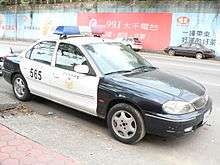
General information
In addition to normal law enforcement duties, police in the ROC are charged with other slightly more unusual duties such as taking census data, as well as immigration and visa related issues.[30] Most jurisdictions also have a Foreign Affairs squad staffed by English speaking officers tasked with visa enforcement and issues relating to foreigners or the foreign community in Taiwan.
With the exception of traffic police in some local departments, all police officers carry small firearms (notably the Walther PPQ pistol, Smith & Wesson M&P compact or Glock sidearms for detectives) and batons. A criticism that has emerged in recent years is that police officers generally do not carry any nonlethal weapons aside from batons such as tasers or pepper spray, limiting their options when dealing with violent criminals. Police in Taiwan have sometimes been known to fire warning shots or at the legs of fleeing suspects, though this practice has reportedly decreased in recent years.
Most police officers patrol in marked police cars or small motorscooters. Motorcycles are typically used only by the traffic police. Police officers patrol with the light bars on their cars turned on. Like many other nations in the Asia Pacific region, the emergency number for police in Taiwan is 1-1-0.
Local Stations
In Taiwan, including islands of Kinmen and Matsu, there are a total of 1,615 various local police stations.[12]
Typically, there are 16 police officers, including a station chief and a sergeant, in a local police station.
Usually, a counter is placed in the 24-hour-opened main entrance and a pistol-armed police officer would sit there as the station duty officer, or watch commander, on a 2-or-4-hour watch. The watch commander is the main funnel between that station and civilians within its area of responsibility. He or she is in charge of the safety of the station, including the security of firearms and ammunition. The station duty officer must answer all personal or telephone complaints from civilians, delegate those reports to proper desk police officers, dispatch police officers on patrol to respond, or provide legal advice to common citizens. Also, the station duty officer would reply to all information requests concerning suspicious persons or vehicles over radio communication.
In remote areas or due to manpower shortage, some local stations are allowed by regulation to close the main gate between 2200 and 0600 hrs, but one police officer must remain inside.
Selection and training
Career police officers are trained at either the Taiwan Police College in Taipei City or the Central Police University in Taoyuan City. The Taiwan Police College provides basic training for entry level police officers assigned to patrol duty, while the Police University provides more advanced training for manager level or active duty officers in forensics, administration, traffic control, fire control and science, border police, crime investigation, maritime police, foreign policy, information management, law and other related subjects.
In 2006, police selection criteria were amended to include all persons with a high school diploma between ages 18–28 able to pass a police civil service exam and undergo one year of training. This removed the past requirement where only graduates of specialized police colleges and universities were allowed to become police officers.[31]
Conscripts may also choose to fulfill their mandatory twenty month national service requirement in the Police Department following basic training. Conscripts are typically deployed to assist local officers in positions such as traffic control, riot control, secretarial work, and basic patrol. Conscripts serving in the police force are generally not issued firearms.
Uniforms

Most police officers, since 1988, wear the standard uniform which consists of dark blue pants, the Combination cap with a gold band or a baseball cap, a jacket or an overcoat in winter, and a light Grey shirt. Dark-blue or yellow windbreakers attached white reflective strips are sometimes also issued, with white letters "POLICE" and "警察" on the back. All uniform buttons or decorations are golden yellow. A golden rank insignia is worn over the right breast pocket of the shirt. Two patches are worn, one on each shoulder: one with the golden NPA insignia, department name, and serial number. The second patch may be optional and is specific to the squad or unit the officer belongs to.
Court bailiffs, volunteer police officers, and civil defense personnel wear the same uniforms with small variations. The cap insignia worn by volunteer police officers is silver white rather than gold, as are the decorations and the shoulder patches. Instead of the golden rank insignia over the right breast pocket, volunteer policemen wear name tags.
Volunteer traffic police personnel wear similar uniforms with same style but with a high visibility orange shirt, and usually bear no rank.
Members of certain SWAT units will usually wear dark blue BDU style uniforms rather than the regular one. Detectives typically dress in plainclothes.
Conscripts serving alternative national service with the police wear khaki uniforms instead of the standard police blue.
Interdepartmental cooperation
Bureau of Investigation
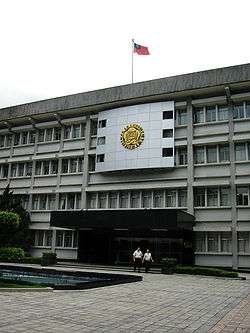
Regarding drugs, corruptions, espionage, and economic crimes, the Investigative Bureau of Ministry of Justice (MJIB) has developed stronger capability to cover cases in those categories for decades. The investigation of these cases, police corruption included, are usually transferred to or led by the Bureau of Investigation.
MJIB officers are equipped with a strong laboratory-testing capacity regarding controlled substances. This gives a necessary advantage and training for the investigators of MJIB. However, the police forces in the ROC still maintain several active drug enforcement squads at the local police departments and the Criminal Investigation Bureau of NPA.
Historically, counter-intelligence affairs are under the turf of MJIB. Different from "special branch" in the police system in United Kingdom, the security divisions at all levels of Taiwan police system are mainly staff units, not fielded police details. Under the supervision of National Security Bureau, all non-mililary cases of espionage would soon be moved to the Bureau of Investigation.
A few years ago, high-ranking police officials tried to develop the strength of investigating white-collar crimes in the ROC police system but gained unnoticed progress. The MJIB is still in the lead position of cracking economic crimes or money-laundry. However, the Criminal Investigation Bureau of NPA has built fair reputation on copyright protection and the safety of computers and networks. Also, regarding the copyright issue, the 1st brigade of the 2nd special police corps is especially tasked for the enforcement related to intellectual property.
Military Police

In the ROC, the usual cases for local police to bring in the military police are military deserters or traffic accidents involving military vehicles or personnel.
The latter one is a very interesting situation, in that ROC civilians tend to shake down the related military units when such kind of accidents occur. For some paranoid thinking, people in the ROC military presume that the local policemen would side with civilians. As an unofficial rule in all ROC armed forces, all military drivers, and commissioned or non-commissioned officers are frequently instructed to call in the military police when they find themselves are in the middle of such a vehicular incident.
Contrary to common belief, military police can actively go after civilian criminals, although usually they choose not to muddle the gray area after the lifting of martial law on 15 July 1987. According to the "Law of the dispatching of Judicial Police Personnel," military police can deal with civilian affairs under the supervision of the public prosecutor(s) from all court prosecutors' offices at all levels under the Ministry of Justice. Sometimes public prosecutors will direct military police to handle large-scale searches or arrests when investigating cases of police-related crimes, prostitution, or fugitive recovery.[32]
Regarding counter-terrorism, there are three company-size troops of special forces under the operational control of the Ministry of National Defense:[33][34]
- Northern Taiwan: Military Police Special Service Company (MPSSC, Code Name: Night Hawk), Military Police Command.
- Central Taiwan: Special Warfare Special Service Company, Aviation, Airborne and Special Warfare Command of the Republic of China Army.
- Southern Taiwan: Marine Special Service Company, Marine Corps Command of the Republic of China Navy.
These three are tasked to handle combat situations involving international terrorists, mercenary or para-military criminals. Bound by laws, currently only the Military Police Special Service Company can react to non-military cases, like airplane hijacking.
Coast Guard

The shore lines of Taiwan are under multiple protections from several law enforcement units in Taiwan.
The history of Taiwan's Coast Guard Administration can be traced back to several origins. One of these is the former 7th Special Police Corps, which was expanded from the late and unique River Patrol squadron of the Taipei County (now New Taipei City) Police Department. The land branches of Coast Guard Administration originate from the controversial Taiwan Garrison Command, which no longer exists, but the formations of land patrol forces were inherited from the ROC Army. Because of its interesting and complicated origins, the Coast Guard Administration does not always go along well with the police, especially when problems related to legal jurisdiction on land occur.
Smuggling and arms trafficking has been a long been an issue in Taiwan. Human-trafficking and its counterpart, prostitution, are increasingly serious problems in Taiwan. The maritime patrol of the Coast Guard Administration have the responsibility to stop those crimes at sea, and the coastal patrol of Coast Guard Administration are responsible for intercepting such criminal cases along the coast of Taiwan. The in-land territory of Taiwan should be the responsibility of individual local police departments or national law enforcement units from the NPA or MJIB.
Cases like smuggling and human-trafficking may cause turf wars between competing law enforcement agencies. In some examples, when brothels were raided by plain-clothes peace officers, the pimp would quietly go to the local police station and gather possible information about his girls in detention, but sometimes the pimp would later find that his girls were held up by the local coastal patrol units.
Fire Brigades
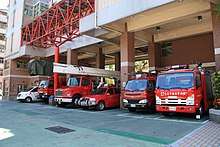
Taiwan Firemen were a part of the Taiwan Police before 1995. At that time, the Fire Policemen were not the most favorite people in the eyes of certain police chiefs. The most extreme case was in Taipei County (now New Taipei City) Police Department: the Taipei County Police Commissioner Yao Kao-Chiao (姚高橋) assigned all his fire policemen to kitchen duty because he felt his fire policemen were doing nothing except waiting for a fire to happen.
It is worth to point out that Yao Kao-Chiao was the Directors-General of Central Police University from May 1995 to June 1996, of National Police Agency from June 1996 to 1997, and of Coast Guard Administration from 28 January 2000 until 21 May 2000.
Also, in Taiwan, another contradiction was the radio call signs for the fire trucks or rescue vehicles. For reasons to avoid unwanted attentions and to remain secrecy, all radio call signs for all police vehicles were uncorrelated with the missions of the subject vehicles, unnecessarily including fire trucks, rescue vehicles, and ambulances of fire brigades. When fire police teams were responding to an emergency situation, these confusing call signs inevitably led to chaos and time delay. A successful fire chief, Chao Kang (趙鋼),[35] convinced the police high command to rearrange the radio call sign assignment for all fire vehicles. Chao Kang then was appointed as the Commissioner of Taiwan Provincial Fire Administration, and the Director-General of National Fire Agency from 10 September 2000 to September 2002.
See also
References
- 明遠 (2001-02-16). 職位調動因人而異 拉警報 (in Chinese). New Taiwan News Weekly. Archived from the original on 2007-05-10. Retrieved 2007-04-17.
- "National Police Administration - Taiwan Intelligence and Security Agencies". GlobalSecurity.org. Retrieved 2006-03-08.
- 張瑞楨 (2005-05-10). 大搜察線 (in Chinese). The Liberty Times. Archived from the original on 2006-12-14. Retrieved 2007-01-13.
- "CIB, NPA, MOI". Criminal Investigation Bureau, National Police Agency, Ministry of the Interior (in Chinese). Retrieved 2008-05-25.
- 陳一雄 (2006-04-07). 科技犯罪防制中心掛牌 李相臣接主任 (in Chinese). United Daily News. Retrieved 2008-06-08.
- 張協昇 (2006-01-31). 魔鬼藍衫軍 彈雨中穿梭 (in Chinese). The Liberty Times. Retrieved 2008-03-06.
- Kennedy, Mark (2004-10-24). "Getting away with murder". The Taipei Times. p. 17. Retrieved 2007-01-16.
- "Table for English and Chinese regarding Special municipality" (xls). Bilingual Living Environment Service System, Research, Development, and Evaluation Commission. Retrieved 2007-01-16.
- "Organization". National Police Agency, ROC Ministry of the Interior. Archived from the original on February 2, 2006. Retrieved 2006-03-08.
- "Table for English and Chinese regarding police units of Taipei City Police Department". Taipei City Police Department. Archived from the original on 2007-09-27. Retrieved 2007-01-16.
- "Table for English and Chinese regarding police personnel titles of Taipei City Police Department". Taipei City Police Department. Archived from the original on 2007-09-27. Retrieved 2007-01-16.
- 黃敦硯、林明宏 (2007-12-31). 1615派出所 愈遠愈有特色 (in Chinese). The Liberty Times. Retrieved 2008-06-30.
- 公務人員保障暨培訓委員會再申訴決定書. 90公申決字第0064 號 (in Chinese). 2001. Retrieved 2007-01-16.
- 淺識警大與警察生涯發展 (in Chinese). Archived from the original on 2007-03-11. Retrieved 2007-01-16.
- (in Chinese) Act of Police Personnel [警察人員人事條例]
- Haddon, R. (1987). "Mimesis and Motivation in Taiwan Colonial Fiction". B. C. Asian Review. Cite journal requires
|journal=(help) - "History". National Police Agency, ROC Ministry of the Interior. 2008-03-28. Retrieved 2008-04-08.
- 政府取締奇裝異服男女. Formosa Television Inc. (in Chinese). Archived from the original on 2006-10-26. Retrieved 2007-02-02.
- 黃建華 (2006-04-24). 前警署長羅張 靈柩覆國旗 警軍高階首長 送最後一程 (in Chinese). The Liberty Times. Retrieved 2007-04-17.
- Peng, Ming-min (January 1972). "Surveillance". A TASTE OF FREEDOM. Retrieved 2008-07-02.
- 劉慶侯、陳曉宜 (April 13, 2004). 《星期人物》王卓鈞講風骨 絕不曲意奉承 (in Chinese). The Liberty Times. Retrieved 2008-07-02.
- 蔣介石派軍統特工遠赴越南追殺漢奸汪精衛內幕 (in Chinese). 環球時報. 2004-12-18. Retrieved 2008-07-02.
- 趙靜瑜 (2001-06-14). 警察故事 道出警徽下的功績與孤獨 (in Chinese). The Liberty Times. Retrieved 2007-07-10.
- 司法院大法官會議 (1995-05-26). 大學法細則就共同必修科目之研訂等規定違憲?. 釋字第 380 號 (in Chinese).
- Lin, Jean (2006-02-28). "MOI details new rules on media access to airport". The Taipei Times. p. 2.
- Jou, Ying-cheng (2000-07-24). "Outrage over river tragedy". The Taipei Times. p. 1.
- Chuang, Jimmy (2005-07-14). "Dreaded gangster caught after gunfight". The Taipei Times. p. 1. Retrieved 2007-01-16.
- "Hou Yu-ih becomes youngest-ever NPA director-general". The Taipei Times. 2006-02-28. p. 3.
- "Taipei police chief to head NPA". China Post. 2008-05-10. p. 1.
- "Regulations Governing the Inspection and Registration of Alien's Residence or Permanent Residence". National Police Agency, ROC Ministry of the Interior. Archived from the original on February 12, 2006. Retrieved 2006-03-08. "The inspection and registration affairs as prescribed in these Regulations shall be planned by the National Police Agency (NPA) of the Ministry of the Interior, and executed by city or county (city) police under the supervision of the NPA before the Bureau of Immigration of the Ministry of the Interior is established."
- "警察特考大幅放寬應考資格,提供有志警察工作者新選擇". ROC Ministry of Examination. Archived from the original on 2007-09-28. Retrieved 2007-11-04.
- 許紹軒 (2005-02-25). 憲調組 四月起併入憲兵隊 (in Chinese). The Liberty Times. p. 11. Archived from the original on 2008-03-11. Retrieved 2007-07-18.
- 陳宗逸 (2006-10-19). 陸軍狙擊兵 神祕曝光 (in Chinese). New Taiwan News Weekly. Archived from the original on 2011-07-18. Retrieved 2008-07-03.
- 陳宗逸 (2008-07-03). 模擬機場攻台 中國準備好了? (in Chinese). New Taiwan News Weekly. Archived from the original on 2011-07-18. Retrieved 2008-07-03.
- 王瑞德 (2002-09-14). 內政部一級主管大搬風 (in Chinese). The Liberty Times. Retrieved 2007-07-10.
External links
| Wikimedia Commons has media related to National Police Agency (Republic of China). |
- National Police Agency, MOI (in Chinese)
- National Police Administration from GlobalSecurity.org
